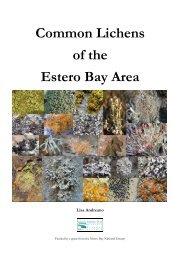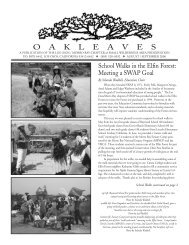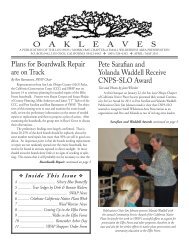O A K L E A V E S An Information-Filled Annual ... - Elfin Forest
O A K L E A V E S An Information-Filled Annual ... - Elfin Forest
O A K L E A V E S An Information-Filled Annual ... - Elfin Forest
Create successful ePaper yourself
Turn your PDF publications into a flip-book with our unique Google optimized e-Paper software.
Fox Sparrow<br />
Text By Jean Wheeler, Ph.D. Photo By Marlin Harms<br />
Our pocket guide (sold on page 11) lists nine species<br />
of sparrows for the <strong>Elfin</strong> <strong>Forest</strong>, four as year-round residents<br />
and five visiting only seasonally. The Fox Sparrow, (Passerella<br />
iliaca) is seldom seen here and only in winter. It is one of the<br />
largest and stockiest of sparrows, with a length of about seven<br />
inches and wingspan to slightly over ten inches. Fox Sparrows<br />
are gray, brown, or reddish brown on the back and head with<br />
reddish brown wings and tails. The breast is heavily streaked<br />
with inverted v-shaped spots varying from light brown to<br />
almost blackish brown. The lower mandible is usually yellow.<br />
There are four visually distinct geographical populations<br />
of this species, which early DNA studies tend to confirm,<br />
and separate species may be recognized with further study.<br />
The bird in Marlin’s photo appears to belong to the Sooty<br />
(Pacific) group, having a uniformly brown back and sooty<br />
brown head.<br />
The Red (or Taiga) Fox Sparrow breeds in northern<br />
Alaska and Canada and winters in southeastern United States.<br />
Its bright reddish patches and streaks the color of red foxes<br />
gave the name to the species. The Slate-colored Fox Sparrow<br />
of the interior west has a plain gray back with redder tail and<br />
wings and a thin beak. The Thick-billed Fox Sparrow of the Sierra<br />
Nevada and Cascade Mountains is colored like the Slate-colored<br />
subspecies, but has a much more massive bill than the other three<br />
groups.<br />
The Sooty Fox Sparrow breeds on the coast from the Olympic<br />
Peninsula of Washington to the Aleutian Islands and winters along<br />
the Oregon and California coasts. The Sibley Guide to Birds notes<br />
that populations of Sooty Fox Sparrows breeding farthest north and<br />
west are palest in color, which matches Marlin’s picture, so his bird<br />
may have traveled here from a nest in the Aleutian Islands!<br />
Male Fox Sparrows sing to defend territory and attract a mate.<br />
Females build bulky nests on the ground or low in shrubs or trees,<br />
made of grasses and sticks and lined with hair, moss, and feathers.<br />
They incubate about two to five eggs for a scant two weeks. Both<br />
parents feed seeds, insects and berries if available, to the young<br />
Fledglings leave the nest in less than two weeks, and the parents<br />
usually raise a second brood.<br />
In winter migration, Sooty Fox Sparrows seek chaparral or<br />
brushy streamside habitat. They are usually solitary rather than<br />
social in behavior and very shy. Ground foragers, they scratch<br />
in leaf litter, jumping backwards pulling debris with both feet to<br />
expose insects as well as seeds. The loud noise they make foraging<br />
is one clue to spotting them, although some of our other species of<br />
sparrows jump and scratch similarly. Their song is a long series of<br />
irregular notes, which are thinner, more buzzy and staccato for the<br />
Sooty subspecies than for the other three Fox Sparrows.<br />
Congratulations, Marlin, for not only spotting this shy and<br />
fairly uncommon winter visitor to our <strong>Elfin</strong> <strong>Forest</strong>, but also for getting<br />
such a wonderful photo of it!<br />
Please Report <strong>Elfin</strong> <strong>Forest</strong> Sightings<br />
Have you observed any unusual birds in the <strong>Elfin</strong> <strong>Forest</strong>?<br />
Mammals? Reptiles? Amphibians? Insects? Interesting activities or<br />
footprints of wildlife in our <strong>Elfin</strong> <strong>Forest</strong>? Unusual plants?<br />
Please report any interesting sightings to your Oakleaves editors<br />
at: oakleaves@elfin-forest.org for inclusion in future issues<br />
under “<strong>Elfin</strong> <strong>Forest</strong> Sightings.” You can also leave a message on<br />
SWAP’s answering machine, (805) 528-0392.<br />
SWAP First Saturday Work Parties<br />
We invite you to join us on any first Saturday from 9 a.m. to<br />
noon at the north end of 15th Street in Los Osos to enjoy satisfying<br />
physical activity in fresh air amid lovely surroundings. Please<br />
dress for wind, fog, or sun. Layers work well. Long pants and long<br />
shirt sleeves are good. Sturdy shoes are a must. Take care not to<br />
park in front of driveways or mailboxes. To request more information,<br />
call (805)528-0392.<br />
Artists: Start Painting For the Next Calendar<br />
The Calendar Committee is beginning work on the 2013<br />
calendar, featuring works by local artists. We want to get<br />
the word out early so that artists will have plenty of time to<br />
go to the <strong>Elfin</strong> <strong>Forest</strong>, select one or more subjects, and begin<br />
painting. Whatever the medium, the end products that the<br />
Calendar Committee wants are full-color digital images on<br />
a CD. The main subject, as always, is the <strong>Elfin</strong> <strong>Forest</strong>. For<br />
more detailed information, call our SWAP message phone,<br />
528-0392.<br />
4







